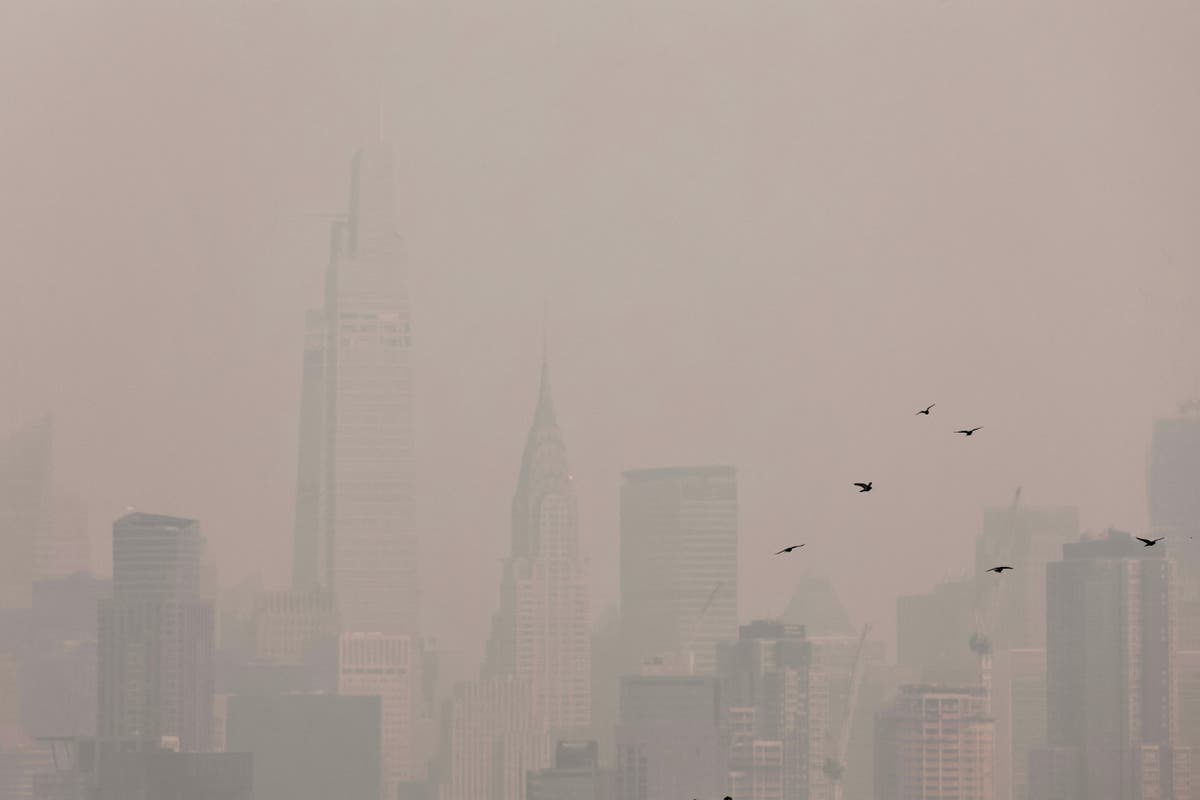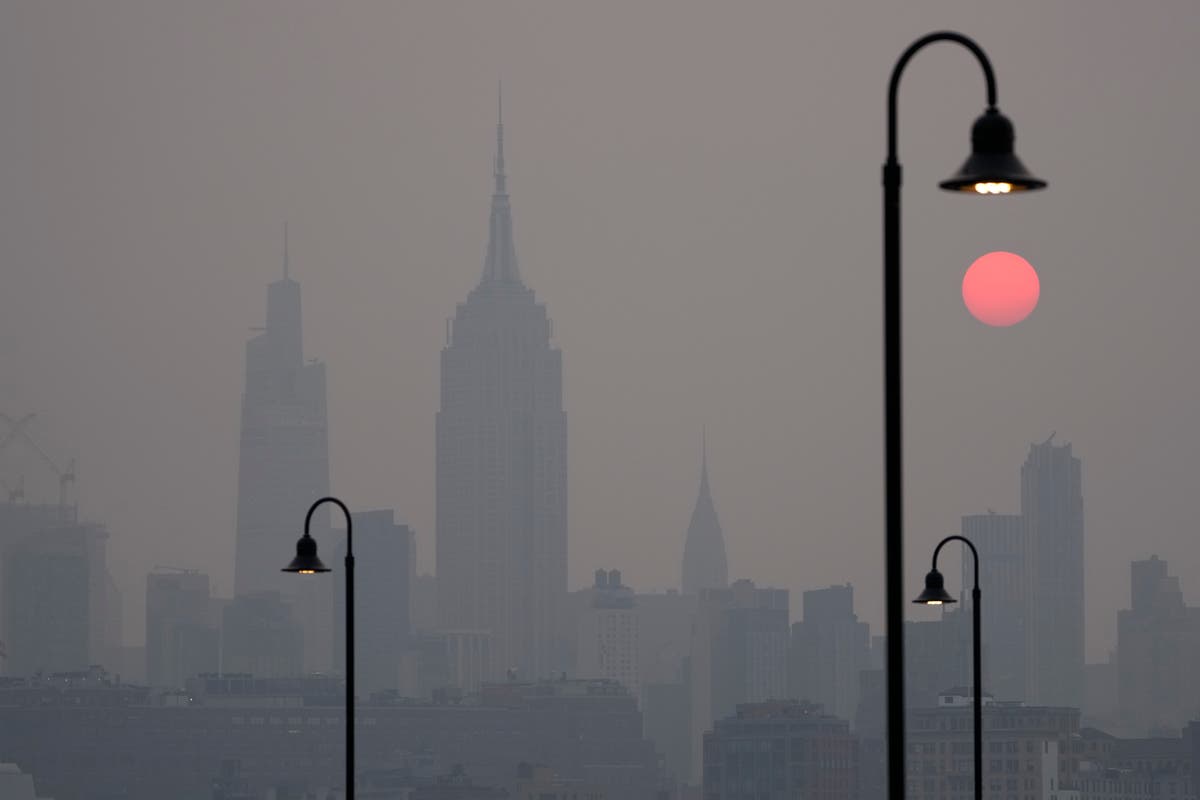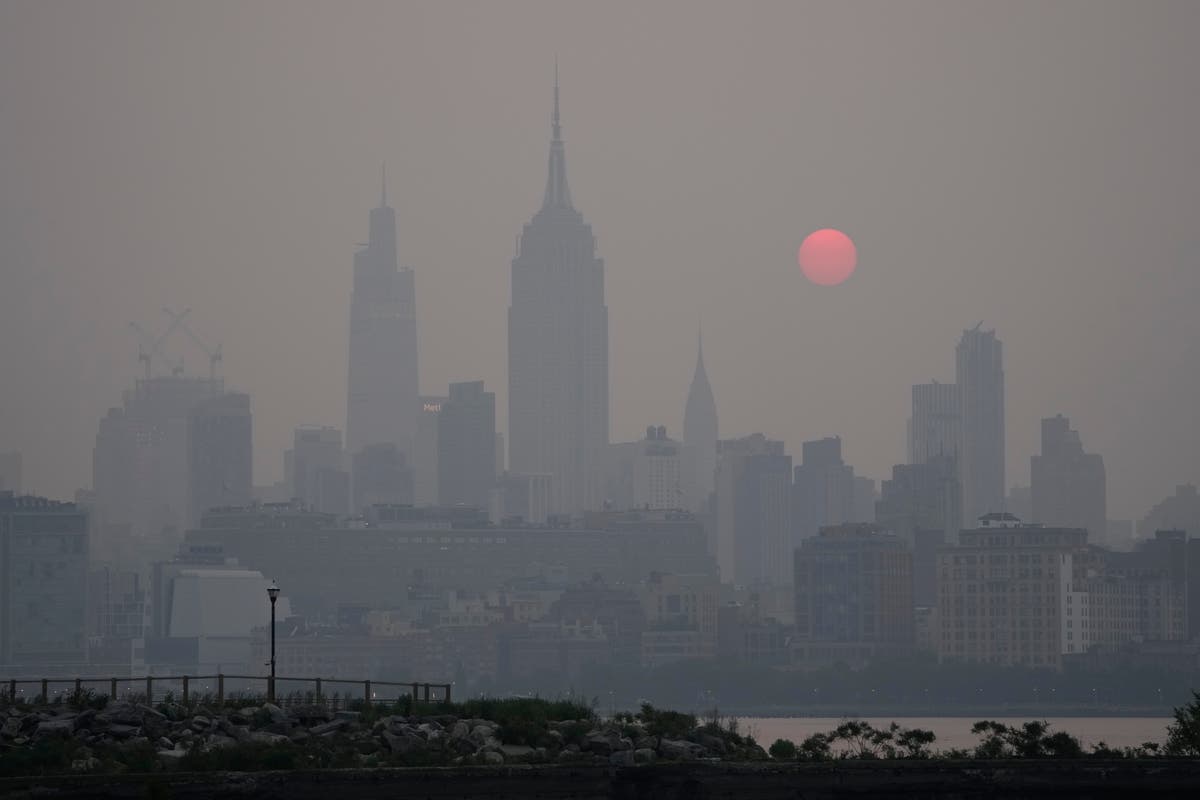Air quality: Noxious smoke eases over US but wildfires still major threat in Canada
The smoke has shifted south and west in the US impacting cities like Chicago, Cincinnati, Pittsburgh and Cleveland after enveloping New York for days
Your support helps us to tell the story
From reproductive rights to climate change to Big Tech, The Independent is on the ground when the story is developing. Whether it's investigating the financials of Elon Musk's pro-Trump PAC or producing our latest documentary, 'The A Word', which shines a light on the American women fighting for reproductive rights, we know how important it is to parse out the facts from the messaging.
At such a critical moment in US history, we need reporters on the ground. Your donation allows us to keep sending journalists to speak to both sides of the story.
The Independent is trusted by Americans across the entire political spectrum. And unlike many other quality news outlets, we choose not to lock Americans out of our reporting and analysis with paywalls. We believe quality journalism should be available to everyone, paid for by those who can afford it.
Your support makes all the difference.Smoke from hundreds of wildfires in Canada reached Europe on Friday after blanketing provinces and large parts of the United States in thick smoke this week.
And while the noxious smoke was finally easing over the northeast on Friday, the fires still posed a major threat.
More than 420 fires are raging across Canada from British Columbia in the west to Nova Scotia in the east. At least half of these fires are burning out of control, and tens of thousands of people have been evacuated from their homes.
While air quality improved in large cities like New York, Washington DC and Philadelphia on Friday, pollution increased across central and southern states including the cities of Chicago, Cincinnati, Pittsburgh and Cleveland.
Global temperature rise, caused by emissions from burning fossil fuels, is leading to more large, erratic wildfires around the world. And it’s a vicious circle: the emissions pumped into the atmosphere by fires add to global heating, further drying out the land and vegetation, making it more susceptible to catching fire.
New York pollution skyrockets as wildfire smoke continues
Yellowing and ashen skies smothered New York City’s skyline on Wednesday as wildfire smoke drifting from Canada sparked unhealthy air conditions across the northeastern US.
Air quality above New York had improved slightly on 7 June but rapidly deteriorated in the afternoon, reaching an air quality index of more than 400 in some parts of the city – the worst level globally – and roughly 58 times the World Health Organization’s guidelines.
The federal government’s index for measuring air quality considers anything above 300 “hazardous”. By comparison, the index over the weekend was 20.
Alex Woodward reports.

New York City air pollution from wildfire smoke spikes to hazardous ratings
Tens of millions of Americans are under air quality alerts in 13 states
Video: George Washington Bridge disappears under smoke from Canadian Wildfires
How long will air pollution in New York last?
New York City has been blanketed in thick smoke last two days with air quality continuing to plummet prompting health alerts across the Northeastern United States.
However, there still seems no end in sight as weather systems are expected to hardly budge.
The smoky blanket billowing from wildfires in Quebec and Nova Scotia and sending plumes of fine particulate matter as far away as North Carolina can persist into Thursday and possibly the weekend, experts say.
That means at least another day, or more, of a dystopian-style detour that’s chased players from ballfields, actors from Broadway stages, delayed thousands of flights and sparked a resurgence in mask-wearing and remote work — all while raising concerns about the health effects of prolonged exposure to such bad air.
The weather system that’s driving the great Canadian-American smoke out — a low-pressure system over Maine and Nova Scotia — “will probably be hanging around at least for the next few days,” US National Weather Service meteorologist Bryan Ramsey said.
Conditions are likely to remain unhealthy, at least until the wind direction changes or the fires get put out.
“Since the fires are raging — they’re really large — they’re probably going to continue for weeks. But it’s really just going be all about the wind shift.”
The Independent’s senior climate correspondent Louise Boyle has this wildfire smoke tracker where you can check where the pollution is headed next:

Wildfire smoke tracker: Where the air pollution is headed next
Stalled weather system in Atlantic means smoky conditions likely to continue into weekend for US northeast
How to protect pets from wildfire smoke
Experts estimate that each hour of exposure to wildfire smoke is equivalent to smoking cigarettes continuously for the same amount of time, but that’s just for humans. Poor air quality may pose an even greater risk to animals because of their much smaller size.
Meredith Clark reports:

How to protect pets from wildfire smoke amid air quality alert
Wildfire smoke may pose an even greater risk to our beloved pets
All the dos and don’ts to keep safe from wildfire smoke
As the wildfires continue to rage on, air quality in New York is expected to remain worse for a few more days, according to forecasters.But amidst an ongoing climate crisis, many climate scientists warn that wildfires could become more frequent and intense, leading to more air pollution.
Many officials have urged people to limit their time outdoors and wear masks to protect themselves from the smoke. In fact, wildfire smoke carries a number of pollutants that can pose a number of risks and hazardous effects.
My colleague Meredith Clark has this list of dos and don’ts to help keep yourself safe during the Code Red air quality alert.

From masks to AC units: All the dos and don’ts to keep safe from wildfire smoke
New Yorkers have been urged to limit their time outdoors and wear masks as wildfire smoke blankets city
Wildfires ground New York-based flights
Federal authorities temporarily grounded flights at New York City’s LaGuardia Airport “due to low visibility” from wildfire smoke smothering the East Coast.
Departures were grounded until 2pm ET on 7 June, according to the Federal Aviation Administration. The agency also delayed flights from the upper midwestern US and on East Coast bound for LaGuardia.
Newark Liberty International Airport, another nearby major travel hub, also announced a ground delay. The airport announced that the “current smoke condition” may impact flights and urged travelers to check with their airlines “to determine the status of your flight.”
Wind patterns bringing smoke across the northeast “could impact travel through the airports,” according to FAA traffic management officer Samuel Ausby. More than 16,200 flights have been delayed and 79 flights were canceled by 1pm on Wednesday, according to FlightAware.
Alex Woodward has the details.

LaGuardia flights temporarily grounded as wildfire smoke clogs air travel across US
New York City’s skies darkened on Wednesday afternoon as wildfire smoke drifted across Northeast
Canadian wildfire evacuees 'won't be able to return to their homes until next week'
Thousands of residents in Canada remain displaced from their homes as raging wildfires continue to wreak havoc, in what has turned out to be the country's "worst wildfire season ever".
The current count stands at over 20,000 evacuees, with approximately 11,400 individuals hailing from remote regions in northern Quebec as authorities fear the number is expected to rise with the fires rapidly expanding their reach.
In a press conference on Wednesday, Quebec premier Francois Legault said evacuees will not be able to return to their communities until next week, CBC news reported.
Mr Legault said dry weather and strong winds are creating dangerous conditions and heavy smoke in areas that have been evacuated so far.
I want us to be realistic and not have rose-coloured glasses. We won’t have rain in the next few days.
Understanding Air Quality alerts: What does 'hazardous' air mean?
As smoke from wildfires in eastern Canada engulfs the US East Coast, air quality alerts in the "hazardous" category have been issued in some areas. But what exactly do "code red", "very unhealthy" or "hazardous" alerts signify?
The Air Quality Index (AQI), presented on the Environmental Protection Agency's AirNow website, employs a colour-coded system to rank air quality on a 500-point scale, providing the public with an easy-to-understand assessment of the health effects of the surrounding air.
The lower end of the scale, which is green, represents healthy air, while the higher ends, colour coded as red, purple and maroon, represent hazardous and extremely unhealthy conditions.
Currently, New York City's air quality falls within the purple category, denoting hazardous conditions.

The AQI takes into account some key measures of air pollution, such as particle pollution, ground-level ozone and gases like carbon monoxide, sulphur dioxide and nitrogen dioxide. With wildfire smoke flowing from Canada, these dangerous gases have increased in the atmosphere, particularly the fine particulate matter called PM2.5, which is a pollutant.
These pollutants can have various health impacts, often leading to respiratory system irritation, inflammation and the potential development of conditions such as asthma and heart disease.
The scale levels are determined based on the concentration of pollutants in the air, measured in parts per million, over specific time periods – usually an hour, eight hours or 24 hours, depending on the pollutant.
While an AQI of orange was unhealthy for vulnerable individuals, an AQI level of red is considered unhealthy for all individuals, with purple deemed "hazardous" for everyone.
There are various health advisories in place urging residents to limit outdoor activities and wear masks specifically designed to filter out fine particles, like N95 masks.
AOC and Bernie Sanders warn that Canada wildfire smoke is sign of climate crisis catastrophe to come
Leaders from across the worlds of politics, entertainment, and activism warned on Wednesday that the wildfire smoke blanketing the East Coast today is a sign of the climate crisis.
“It bears repeating how unprepared we are for the climate crisis,” New York congresswoman Alexandria Ocasio-Cortez wrote on Twitter on Wednesday, referencing the smoke and recent soaring temperatures in Puerto Rico. “We must adapt our food systems, energy grids, infrastructure, healthcare, etc ASAP to prepare for what’s to come and catch up to what is already here.”
Fellow progressive Bernie Sanders sounded a similar note, writing on Twitter: “Right now, 98 MILLION people on the East Coast are under air quality alerts from Canadian fires and, last night, NYC had the worst air quality in the world.”
More details in our full story.

AOC and Bernie warn that Canada wildfire smoke is sign of climate crisis catastrophe
115 million Americans under air quality alerts




Join our commenting forum
Join thought-provoking conversations, follow other Independent readers and see their replies
Comments